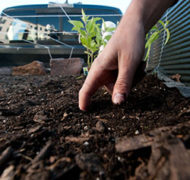The Hard Work of the Harvest
Blog / Produced by The High Calling
This summer my friend Kelli showed me her stash of red plastic coffee cans stacked neatly in a cupboard in her garage. She removed the black lid and scooped out a heaping handful of seeds, then let them fall back into the container again.
She encouraged me to try it for myself.
The effect mesmerized me—like playing with sand in one of those miniature office sand gardens.
The canister was nearly full. I scooped a handful and rubbed my thumb back and forth across the seeds, letting them fall back into the canister. I hadn’t expected them to be so dry.
I scooped another handful and repeated the process.
“But how?” I wanted to know. How had she amassed so many?
We walked to her flower garden, where she picked a spent bloom. She plucked the dead petals, pulled back the “wrapper,” and revealed a band of seeds. She pinched the base of the bloom and twirled it back and forth between her fingers, releasing gobs of black-tipped seeds.
I was hooked.
That afternoon, I left her house with half a dozen empty red coffee containers of my own and a determination to harvest my own marigold seeds.
This spring we had planted our own crop of marigolds, store-bought seeds sewn into soil around our tomato plants to keep the bugs away. By mid-summer blooms of orange and yellow were taller than our middle school daughter.
A few weeks later when she and one of her friends were hanging out, I remembered the red coffee containers. I was pretty sure neither of them had experienced the marvel of harvesting seeds, so I invited them to join me.
We sat around the kitchen table and sifted seeds between our fingers. When we finished, we labeled the canister and set it on a table downstairs near the dehumidifier. The seeds will dry throughout fall and winter months, and if all goes well, we’ll plant them in early spring.
Since then I’ve plucked dozens more blackened marigolds and collected hundreds of seeds. Maybe thousands.
A couple of weeks ago, I deemed myself an expert and decided to try my hand at harvesting lettuce seeds as well. By summer’s end, the lettuce was too bitter to eat, so I allowed the plants to “go to flower.” White fluffy blooms (similar to dandelions) dotted the tips of each plant.
I plucked the flowers, pinched off the ends, and twirled the bud to release the seeds onto a paper plate. Voila! Tiny lettuce seeds sprinkled out and spiraled downward, making a “Plick, plick, plick, plick, plick,” sound as they bounced onto plastic coating.
After a while, my fingers were sticky, and greenish dirt gathered in a crescent under my thumbnail. (I’ve since learned that if you leave the flower on the plant a few more days, the petals dry out and the task is less sticky.)
Harvesting seeds is time-consuming work. It’s much easier to pick up lettuce or marigold seeds for a few bucks at the local garden store, order them online from a seed catalog company, or add a few packets to the grocery cart at the Stuff-mart.
To be honest, I never gave much thought to the workers who tediously remove seeds from spent blooms. But I did that afternoon as I stood at the kitchen sink and washed marigold and lettuce residue from my hands.
As I whisked the fingernail brush back and forth, scrubbing away at the greenish crescent, I wondered if I’d gotten it wrong all these years, believing that Jesus’ call to harvest was glamorous work for those elite missionary types. Maybe it’s more like a call to get my hands dirty, I thought.
I barely breathed as my eyes followed yellow and green soap bubbles swirling down the drain.
EDITOR'S NOTE: Just across the street from my home, the field of corn that grew to block our view most of the summer now lays flat after harvest. The stalks have been stripped bare and fallen; the ears full of grain have been plucked and seeded. It's that time again, at least here in the Midwest. It's the season when the work pays off. On Thursday mornings in September, we are exploring the harvest. Join us as we save seeds from flower pods, fight pests in the garden, and keep working even when the harvest is a long way off. And if you have a minute to spare, drop us a note in the comments to tell us what you have been harvesting this fall.
Other posts about the harvest:
- The Hard Work of Harvest by Cheryl Smith
- Rediscover the Quiet Joy of Patience and Baseball by Laura Boggess
- When You Think Your Work Isn't Making a Difference by Deidra Riggs
- Dying Well: The Ultimate Harvest by Dena Dyer
- The High Calling of Harvesting by Charity Singleton Craig
Image by USDAGov. Used with permission. Sourced via Flickr. Post by High Calling Facebook Editor, Cheryl Smith.





